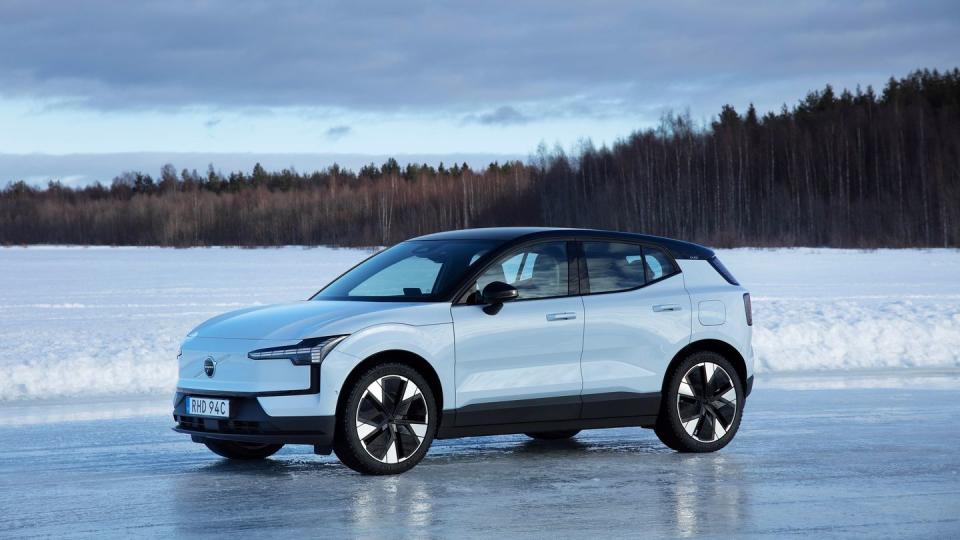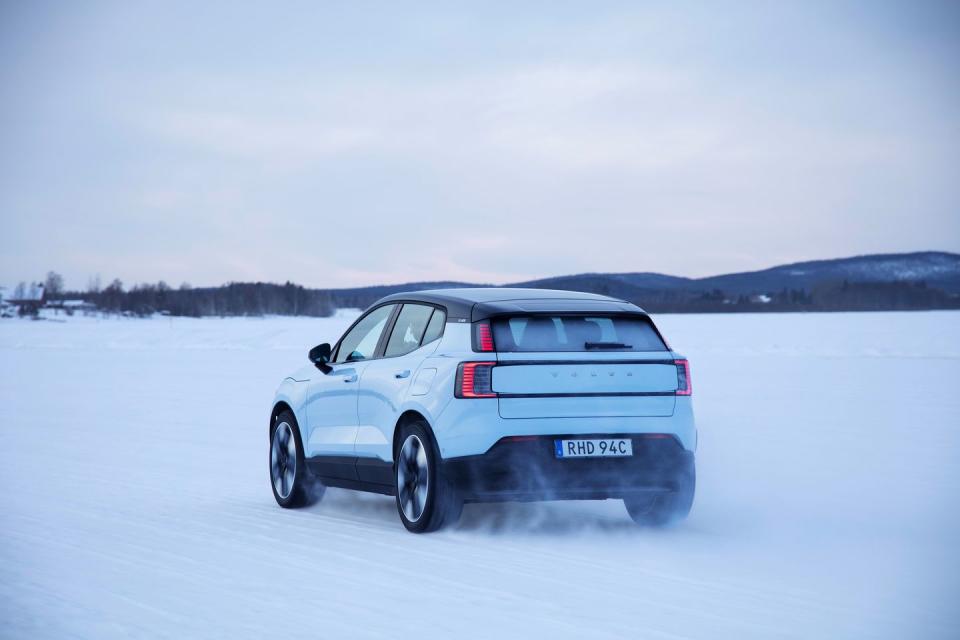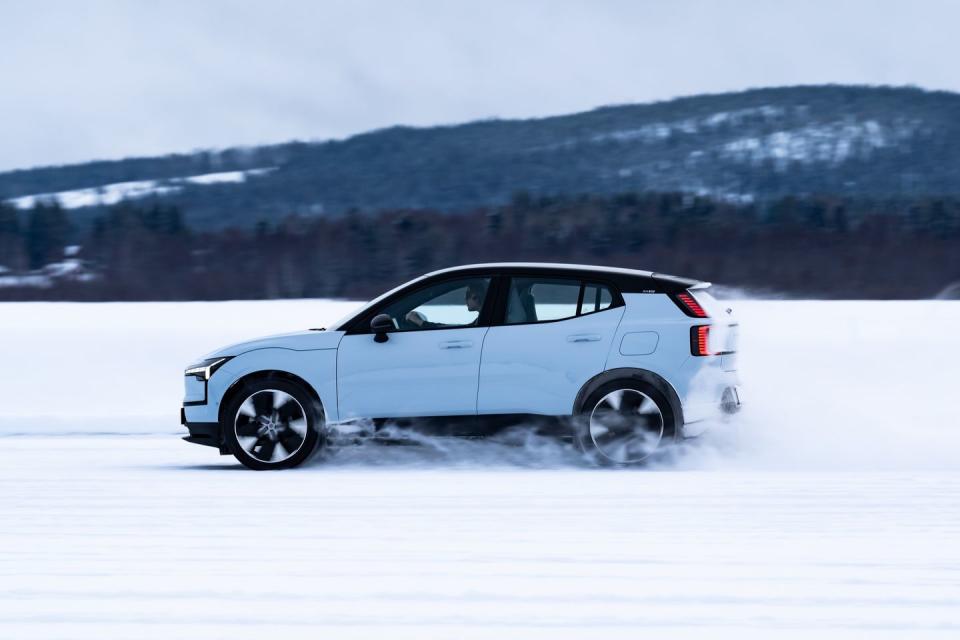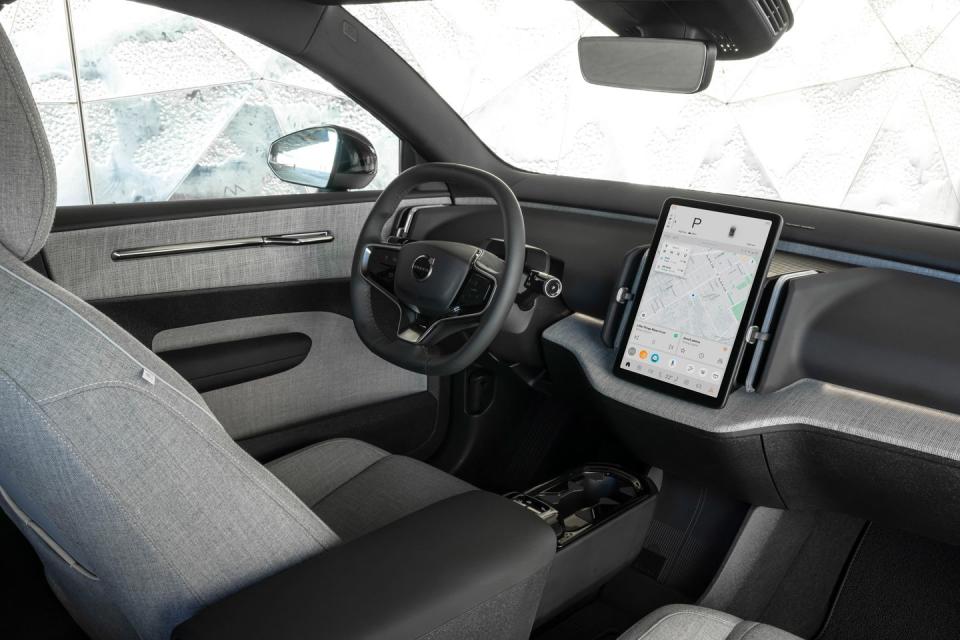2025 Volvo EX30 May Be Small in Size, but Is Big in Snow and Ice

The attractively priced EX30 plug-in can easily hang with older IC Volvos that share sub-arctic forest roads with moose and reindeer during long northern winters.
Volvo’s EX30 ranges from enjoyably engaging on an Arctic ice track to frustratingly, reliably, dead-nuts safe.
The payback for green Arctic winters is a significant reduction in range per-charge, and only potential owners can decide if the price is too steep.
Volvo wants you to know that its electric cars, starting with the brand new EX30 SUV, are true to their Nordic roots, up to the rigors of Arctic winter, and safe in the most challenging driving conditions. To demonstrate this fundamental, the company brought a bunch of auto writers to drive EX30s on roads and ice tracks near the Arctic Circle in Sweden.
After a couple days in a land where winter sun hardly shines, we can tell you the EX30 is definitely, classically, Volvo safe.
The 2025 EX30 is also small by SUV standards. Measuring 166.7 inches bumper to bumper, it’s 2.5 feet shorter than the long-running Volvo XC90. It’s eight inches shorter than the familiar XC40 compact and three inches shorter than a Chevy Bolt EUV. The EX30 is snugger than the aforenamed SUVs, and nimbler, with less up-high mass and less directional sway.
It comes in two flavors. The Single Motor Extended Range has one motor powering the rear axle, with 268 horsepower and 253 lb-ft of torque. It hits 60 mph from a stop in 5.1 seconds, according to Volvo, with a governed 112-mph top speed and projected EPA range of 275 miles from its 69-kWh battery.
The Two Motor Performance EX30 adds a motor for the front axle, increasing output to 422 hp and 400 lb-ft. It drops the 0-60 time to 3.4 seconds, with the same top speed and projected range of 268 miles with the same battery.

Moreover, thanks to clever design and cost-saving tricks (including a dearth of manually operated switches), the rear-drive EX30 retails at $36,245 with destination. That’s rare among electric cars, luxury badge or otherwise. It’s on par with some comparably equipped IC cars and more than $10,000 below the average new car transaction price in March, 2024.
Safety? Start on a frozen lake, roughly 60 miles northeast of Lulea. We’re not talking slalom here, though Volvo had one of those too. We’re talking something more like a road course, with several dozen corners over two miles, plowed through the snow over 36 inches of ice.
The best way to drive the Single Motor EX30 on an ice track is not to overdrive. Stay light on the steering and brake gently only toward the end of the faster bits, and leave the stability control on. Do that—let the nannies do what they were developed to do—and driving the Single Motor becomes a matter of keeping it between the lines with the steering wheel.
On a very low-friction surface, you won’t be going very fast, but you’ll be going steady, without stress or interruption. The electronics let you keep it close to flat, the way you might drive a big-tired, underpowered car around a paved oval. That’s what we mean by classically Volvo safe.

Sure, you can dial back the stability control (you can’t turn it off) and pretend you’re Kalle Rovanperä in Rally Finland, and slide and bounce off the berms. The higher intervention threshold just allows more rear wheel spin (in case you need to get unstuck), and even light throttle wants to overpower the studded Michelin X-Ice North4s on the back of the EX30.
Brake harder and later and go deeper and you’ve not only ruined this corner, but also the next two or three. The rally-racer approach just wrecks your consistent momentum and eventually leaves you in a snowbank. It almost certainly won’t get you through those dozens of turns any faster.
No, if it’s slippery fun you seek, the Dual Motor EX30 is the choice. With considerably more power and motive force spread to all four tires, the Dual Motor naturally accelerates more quickly on groomed ice.
Performance Mode locks it in all-wheel drive, rather than shutting down the front motor whenever possible in the name of efficiency, and delivers roughly 40/60 torque distribution front to rear. This EX30 has good weight distribution, mass low in its chassis, and nothing like dive in the sort of braking you’ll do on ice. Here, there’s some advantage to trying harder.
It’s still better to start turning early. Yet if you tap the brake at the right instance, then give the Dual Motor some gas, er, wattage, its plowing front tires will bite and power up as aggressively as the studs allow, and you can actually accelerate out of a bend on ice.
Ham-fisted aggression is not as obviously counter-productive as it is in the Single Motor. The Dual Motor’s rearward torque bias allows a bit of slide at the rear wheels without completely losing traction in front, and four-wheel power makes it easier to regain lost momentum. Imagine, old-timers! Fun on the ice in a little electric car.

How many EX30 buyers will take their plug-in to the nearest ice track? Five? Twenty? Absurd? What’s certain is that many more will occasionally drive through blizzards, or down snowy, icy, untreated roads. The same things that get the EX30 around an ice track in good form will be valuable in circumstances common across northern swathes of the United States, or Canada.
In Arctic Sweden, the locals drive their older Volvos at an impressive, confident clip through forest roads frequented by moose and reindeer—sometimes cleared, sometimes hard packed snow, often spread with a gravel-like traction aid. In active blizzard conditions, neither EX30 has trouble keeping pace. Ride quality is firm, but never punishing, and even with studded tires the way is quietly serene.

So it’s electric-car paradise, yes? Maybe not. On the ice track, you’ll miss sensory inputs—starting with the sonics and vibration of a revving gasoline engine—that many of us have used for decades. It matters, though it probably matters less to a 26-year-old.
Most practically, there’s the obvious. The EX30 can comfortably transport people through very cold, difficult conditions, if you ever seriously doubted that, but for how long?
Volvo swapped test cars frequently—only partly because they got thoroughly coated with snow build-up and grime—and there was no opportunity to get a bead on the EX30’s range. Yet one supervising engineer told us that, other things equal, you could expect it to drop 25 percent in freezing temperatures (compared to ambient 70 degrees F).
That’s just the start. In northern Sweden, temperature drop below zero for extended streaks, and the range degradation curve gets steeper as temperature falls. Then there’s the studded snow tires that are essential in such places, and even how warm you want to be.
The EX30 is an early adapter of the automotive heat pump, and we stayed more than warm enough—not just slogging around the ice track, but driving casually, outerwear removed. Yet the warmer you need to stay, when the temp falls below zero, the further you’ll degrade range. It’s not hard to envision a 40-50% reduction in miles per charge.
In Norway, where the fastest DC chargers are everywhere, it probably matters less. In International Falls, Minnesota, or Sidney, Montana, it would seem to matter more. Only you can decide how much range is enough.

 Yahoo Autos
Yahoo Autos 